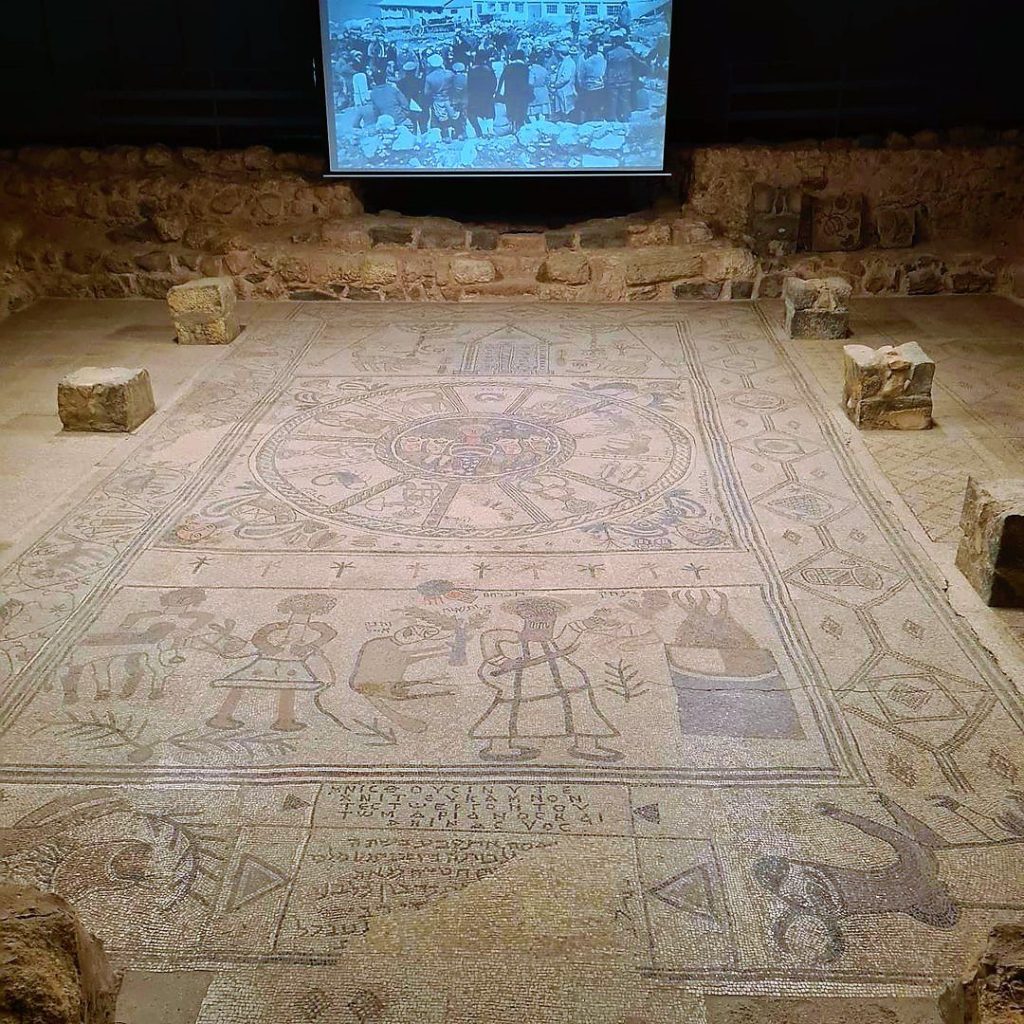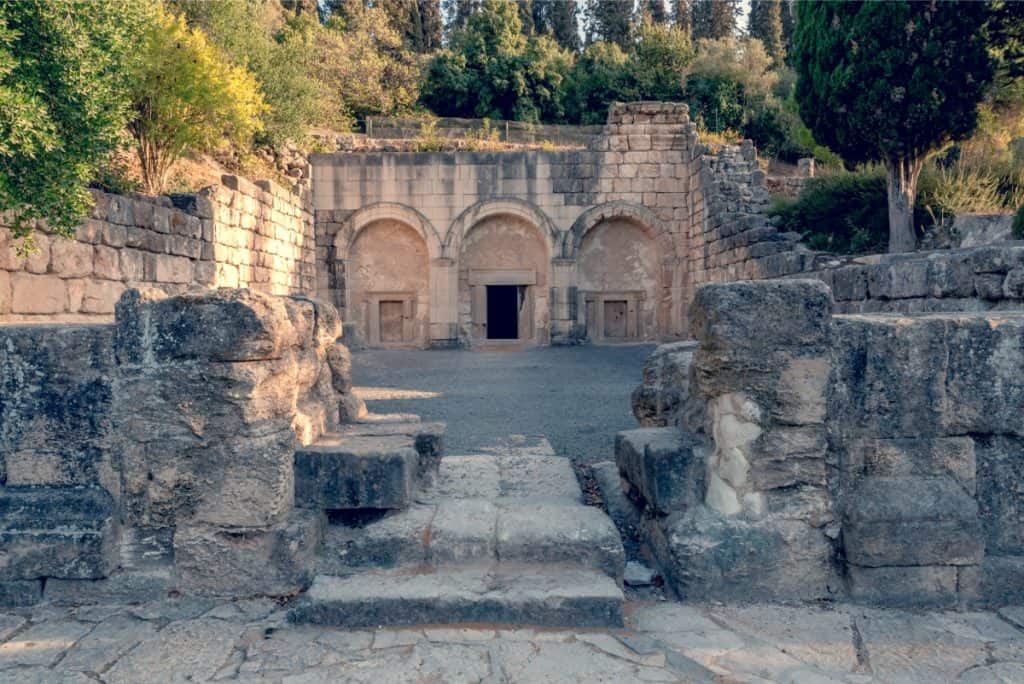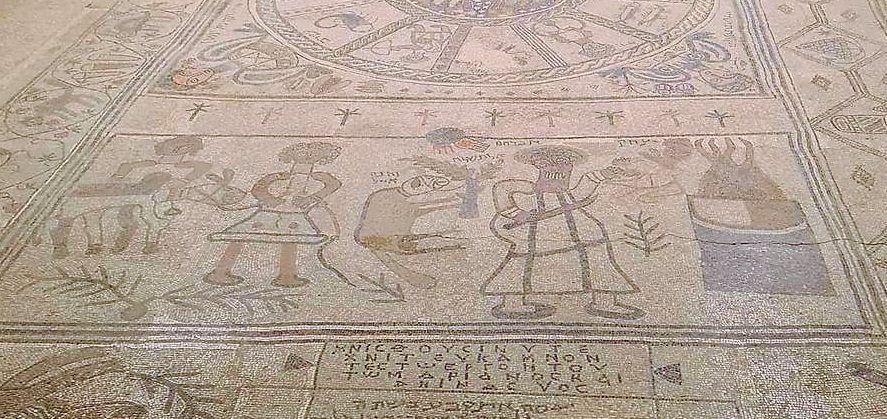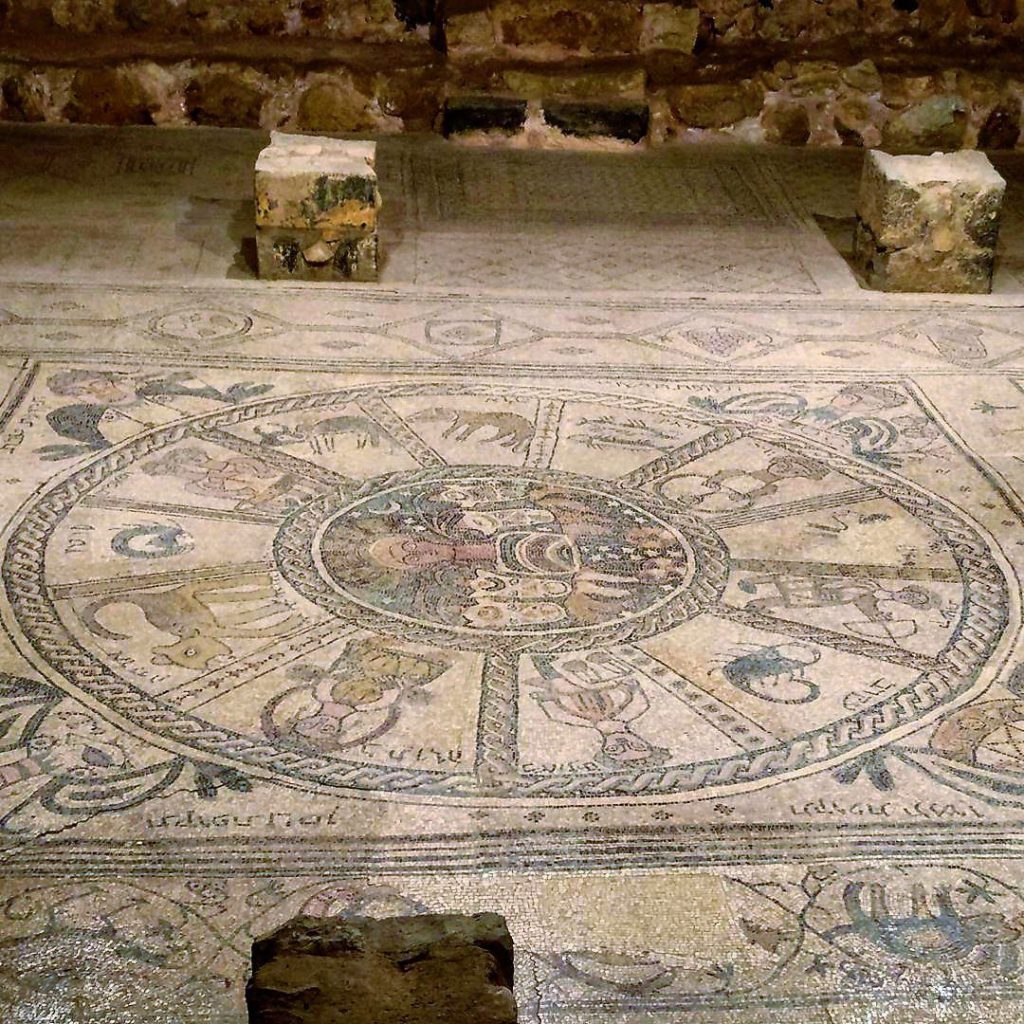Beth Alpha is a sixth-century CE synagogue located at the foot Mt. Gilboa near Beit Shean National Park. The Story goes back to 1928 when members Kibbutz Hefzibah, stumbled upon the synagogue’s extensive mosaic floors during some construction work. Excavations began in 1929 under the auspices of the Hebrew – U, led by Israeli archaeologist, Eleazar Sukenik. A secondary round of excavations, sponsored by the Israel Antiquities Authority in 1962; further explored the residential structures surrounding the synagogue. In addition, a hoard of 36 Byzantine coins was found in a shallow depression in the floor apse.

The Synagogue’s Interior and Architecture
Architectural remains from the Beth Alpha synagogue indicate that the synagogue once stood as a two-story basilical building and contained a courtyard; vestibule, and prayer hall. The first floor of the prayer hall consisted of a central nave; the apse, which served as the resting place for the Torah Ark; and a raised platform upon which the Torah would have been read; and benches. Moreover, the Torah Ark within the apse was aligned southwest; in the direction of Jerusalem.
Beit Shearim National Park

So the northern entryway of Beth Alpha synagogue features two dedicatory inscriptions in Aramaic and Greek. Although partially destroyed, the Aramaic inscription indicates that the synagogue was built during the reign of the Byzantine Emperor Justinus; probably Justin I (518–527 CE); and was funded by communal donations. The Greek inscription thanks artisans “Marianos and his son Hanina”; who were also listed as the artisans of the nearby Beth Shean synagogue. The inscriptions are flanked on either side by a lion and a buffalo, who serve as the Beth Alpha Synagogue’s symbolic guardians.
The Beth Alpha Synagogue Mosaic
The northern panel depicts the “Binding of Isaac” (Genesis 22: 1–18). To the right, Abraham is depicted dangling Isaac over the fiery altar as he raises his hand to perform the sacrifice. In the center, God, symbolized by the small fire-encircled hand appearing in the upper center, instructs Abraham to sacrifice a nearby ram instead of Isaac.
The famous saying aptly labels the hand of God: “do not raise”; taken from God’s command to the angel that Abraham not “raise his hand against the Isaac” (Genesis 22:12). In the lower center of the composition, immediately below the hand of God; the ram that served as Isaac’s substitute is positioned standing sideways, trapped in the nearby thicket.
Furthermore, the odd positioning of the ram may be a convention the artists used to convey the distance that the Bible says separated Abraham and Isaac; from the two servant boys (Genesis 22:5), who accompanied Abraham and Isaac on their journey and are depicted standing to the left. All the figures in the scene, except the two servants, are identified with Hebrew labels.
Also, the iconographic significance of the “Binding of Isaac” is unclear. In fact, there is a wide variety of opinions, with some scholars seeing this narrative as an affirmation of God’s mercy, others as symbolic of his continuing covenant with Israel, and others as embodying the rabbinic notion of “zechut avot” or the merit of the fathers. In contemporary Christian church art, where the “Binding of Isaac” was also a popular theme; the narrative was seen as a typological pre-figuration for the crucifixion.

Central Panel — Zodiac Wheel
So the central panel features a Jewish adaptation of the Greco-Roman zodiac. The zodiac consists of two concentric circles, with the twelve zodiac signs appearing in the outer circle and Helios, the Greco-Roman sun god, appearing in the inner circle. The outer circle consists of twelve panels, each corresponding to one of the twelve months of the year and containing the appropriate Greco-Roman zodiac sign.
Also, female busts symbolizing the four seasons appear in the four corners immediately outside the Beth Alpha Synagogue’s zodiac. In the center, Helios appears with his signature Greco-Roman iconographic elements, such as the fiery crown of rays adorning his head and the highly stylized quadriga or four-horse-drawn chariot. The background is decorated with a crescent-shaped moon and stars. As in the “Binding of Isaac” panel, the zodiac symbols and seasonal busts are labeled with their corresponding Hebrew names.
In fact, this zodiac wheel, along with other similar examples found in contemporary synagogues throughout Israel, such as Naaran, Susiya, Hamat Tiberias, Huseifa, and Sepphoris. The Zodiac wheel rests at the center of a scholarly debate regarding the relationship between Judaism and general Greco-Roman culture in late antiquity. Some interpret the zodiac’s popularity within synagogue floors as evidence for its Judaization and adaptation into the Jewish calendar and liturgy.
Theories About a Zodiac Placed in Jewish Synagogues
While others see it as representing the existence of a “non-Rabbinic” or a mystical and Hellenized form of Judaism that embraced the astral religion of Greco-Roman culture, in other words, it may be that the Jews living in the area in those days felt quite comfortable with their Jewish identity on one hand while embracing foreign elements from other cultures at the same time. I guess the best example is those orthodox kids that run along the streets of Brooklyn, and on their head rests a New York Knicks Yamaka.
Southern Panel—Synagogue Scene
So the southern panel, which was laid before the Beit Alpha synagogue’s Torah Shrine; is a liturgically oriented scene that emphasizes the centrality of the Torah Shrine. The Torah Shrine stands at the center of the composition and is depicted with a gabled roof. The Torah Shrine is decorated with ornamented panels featuring diamonds and squares. The floating conch shell seen in the center of the roof is a stylized representation of the Torah Shrine’s inset arch. A hanging lamp is suspended from the gable of the roof. As a symbolic marker of its importance, the lower register of the Torah Shrine is flanked by two roaring lions and is surrounded by Jewish ritual objects such as the Lulav (a closed frond of the date palm tree), Etrog (Citron), Shofar (Ram’s Horn); and incense shovel. Also, two birds flank the gabled roof in the upper register of the Torah Shrine.

Also, two large seven-branched Menorah (the Jewish Candelabrum) candelabras stand on either of the Torah shrines. The base and branches of the two Menorot are not identical in form; the right-hand Menorah has an upright base, while the left-hand Menorah has two crescent-shaped legs and one upright leg. Lastly, the entire scene is framed by the two pulled-back curtains, which served to demarcate the sacred space of the Torah Shrine.
The Menorah
The presence of the Menorah, which originally stood in the Jerusalem Temple, highlights the continuing importance that the Jerusalem Temple occupied in developing the synagogue. Additionally, the Menorah also maintained a practical function; as the primary light source for the area around the Torah Shrine. Furthermore, Sukenik believed that the two Menorot depicted flanking the Torah Shrine in this scene likely stood adjacent to the Torah Shrine within the actual Beth Alpha synagogue.
Beth Alpha Synagogue: Opening Hours
Summer hours: Sunday–Thursday and Saturday: 8 AM -5 PM
Friday and holiday eves: 8 AM-4 PM
Winter hours:
Sunday–Thursday and Saturday: 8 AM – 4 PM
Friday and holiday eves: 8 AM – 3 PM
Holiday eves: 8 AM – 1 PM
Yom Kippur eve: 8 AM – 1 PM
Phone: +(00)972(0)4-6532004







